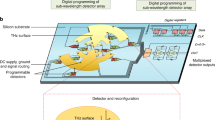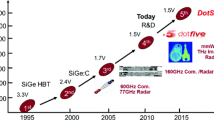Abstract
We propose a scalable, low-noise imager architecture for terahertz recordings that helps to build large-scale integrated arrays from any field-effect transistor (FET)- or HEMT-based terahertz detector. It enhances the signal-to-noise ratio (SNR) by inherently enabling complex sampling schemes. The distinguishing feature of the architecture is the serially connected detectors with electronically controllable photoresponse. We show that this architecture facilitate room temperature imaging by decreasing the low-noise amplifier (LNA) noise to one-sixteenth of a non-serial sensor while also reducing the number of multiplexed signals in the same proportion. The serially coupled architecture can be combined with the existing read-out circuit organizations to create high-resolution, coarse-grain sensor arrays. Besides, it adds the capability to suppress overall noise with increasing array size. The theoretical considerations are proven on a 4 by 4 detector array manufactured on 180 nm feature sized standard CMOS technology. The detector array is integrated with a low-noise AC-coupled amplifier of 40 dB gain and has a resonant peak at 460 GHz with 200 kV/W overall sensitivity.













Similar content being viewed by others
References
Hai-Bo Liu et al., “Sensing minute changes in biological cell monolayers with THz differential time-domain spectroscopy,” Biosensors and bioelectronics, vol. 22, no. 6, pp. 1075–1080, 2007.
Albert Redo-Sanchez, Norman Laman, Brian Schulkin, and Thomas Tongue, “Review of Terahertz Technology Readiness Assessment and Applications,” Journal of Infrared, Millimeter, and Terahertz Waves, vol. 34, no. 9, pp. 500–518, 2013.
Zachary D Taylor et al., “THz medical imaging: in vivo hydration sensing,” Terahertz Science and Technology, IEEE Transactions on, vol. 1, no. 1, pp. 201–219, 2011.
Hani Sherry et al., “A 1kpixel CMOS camera chip for 25fps real-time terahertz imaging applications,” in Solid-State Circuits Conference Digest of Technical Papers (ISSCC), 2012 I.E. International, 2012, pp. 252–254.
Naoki Oda et al., “Development of terahertz focal plane arrays and handy camera,” in SPIE Defense, Security, and Sensing, 2011, pp. 80121B–80121B.
Stefan Funkner, Gudrun Niehues, Diedrich A Schmidt, and Erik Br, “Terahertz Absorption of Chemicals in Water: Ideal and Real Solutions and Mixtures,” Journal of Infrared, Millimeter, and Terahertz Waves, pp. 1–15, 2013.
Zoya Popovic and Erich N Grossman, “THz metrology and instrumentation,” Terahertz Science and Technology, IEEE Transactions on, vol. 1, no. 1, pp. 133–144, 2011.
Markus Schirmer et al., “Biomedical applications of a real-time terahertz color scanner," Biomedical optics express, vol. 1, no. 2, pp. 354–366, 2010.
Erik Ojefors, Ullrich R Pfeiffer, Alvydas Lisauskas, and Hartmut G Roskos, “A 0.65 THz focal-plane array in a quarter-micron CMOS process technology,” Solid-State Circuits, IEEE Journal of, vol. 44, no. 7, pp. 1968–1976, 2009.
Toshihiko Ouchi et al., “Terahertz Imaging System for Medical Applications and Related High Efficiency Terahertz Devices,” Journal of Infrared, Millimeter, and Terahertz Waves, pp. 1–13, 2013.
Sheng-Hui Ding, Qi Li, Yun-Da Li, and Qi Wang, “Continuous-wave terahertz digital holography by use of a pyroelectric array camera,” Optics letters, vol. 36, no. 11, pp. 1993--1995, 2011.
Martin S Heimbeck, Myung K Kim, Don A Gregory, and Henry O Everitt, “Terahertz digital holography using angular spectrum and dual wavelength reconstruction methods,” Opt. Express, vol. 19, no. 10, pp. 9192–9200, 2011.
Yan Zhang, Weihui Zhou, X Wang, Y Cui, and W Sun, “Terahertz digital holography,” Strain, vol. 44, no. 5, pp. 380–385, 2008.
S Wang and XC Zhang, “Pulsed terahertz tomography,” Journal of Physics D: Applied Physics, vol. 37, no. 4, p. R1, 2004.
Xinke Wang, Ye Cui, Wenfeng Sun, and Yan Zhang, “Terahertz digital holography,” in Photonics and Optoelectronics Meetings 2011, 2012, pp. 833003–833003.
Tatiana Latychevskaia, Jean-Nicolas Longchamp, and Hans-Werner Fink, “When holography meets coherent diffraction imaging,” Optics express, vol. 20, no. 27, pp. 28871–28892, 2012.
B Szentpáli et al., “Thermopile antennas for detection of millimeter waves,” Applied Physics Letters, vol. 96, no. 13, pp. 133507–133507, 2010.
Tamer A Elkhatib et al., “Enhanced plasma wave detection of terahertz radiation using multiple high electron-mobility transistors connected in series,“ Microwave Theory and Techniques, IEEE Transactions on, vol. 58, no. 2, pp. 331–339, 2010.
Tamer A Elkhatib, Dmitry B Veksler, Khaled N Salama, X-C Zhang, and Michael S Shur, “Enhanced terahertz detection using multiple GaAs HEMTs connected in series,” in Microwave Symposium Digest, 2009. MTT'09. IEEE MTT-S International, 2009, pp. 937--940
D. L. Donoho, “Compressed sensing,” Information Theory, IEEE Transactions on, Vol. 52, No. 4, pp. 1289–1306, 2006.
Ryan Robucci, Jordan D Gray, Leung Kin Chiu, Justin Romberg, and Paul Hasler, “Compressive sensing on a CMOS separable-transform image sensor,” Proceedings of the IEEE, vol. 98, no. 6, pp. 1089–1101, 2010.
Franz Schuster et al., “Broadband terahertz imaging with highly sensitive silicon CMOS detectors,” Opt. Express, vol. 19, no. 8, pp. 7827--7832, Apr 2011
Jerome Bobin, J-L Starck, and Roland Ottensamer, “Compressed sensing in astronomy,” Selected Topics in Signal Processing, IEEE Journal of, vol. 2, no. 5, pp. 718–726, 2008.
David Gross, Yi-Kai Liu, Steven T Flammia, Stephen Becker, and Jens Eisert, “Quantum state tomography via compressed sensing,” Physical review letters, vol. 105, no. 15, p. 150401, 2010.
Wai Lam Chan et al., “A single-pixel terahertz imaging system based on compressed sensing,” Applied Physics Letters, vol. 93, no. 12, pp. 121105–121105, 2008.
Claire Watts, Willie Padilla, and David Shrekenhamer, “THz Imaging With Metamaterials,” in Infrared millimeter and terahertz waves, 2013 International Conference on, 2013, pp. 1–2.
Luis Mancera and Javier Portilla, “L0-norm-based sparse representation through alternate projections,” in Image Processing, 2006 I.E. International Conference on, 2006, pp. 2089–2092.
Hosein Mohimani, Massoud Babaie-Zadeh, and Christian Jutten, “A Fast Approach for Overcomplete Sparse Decomposition Based on Smoothed L0 norm,” Signal Processing, IEEE Transactions on, vol. 57, no. 1, pp. 289–301, 2009.
N. Kawai és S. Kawahito, „Effectiveness of a correlated multiple sampling differential averager for reducing 1/f noise,” IEICE Electronics Express, Vol. 2, No. 13, pp. 379–383, 2005.
Jarvis Haupt and Robert Nowak, “Signal reconstruction from noisy random projections,” Information Theory, IEEE Transactions on, vol. 52, no. 9, pp. 4036–4048, 2006.
S Preu et al., “An improved model for non-resonant terahertz detection in field-effect transistors,” Journal of Applied Physics, vol. 111, no. 2, pp. 024502–024502, 2012.
Michael Dyakonov and Michael Shur, “Shallow water analogy for a ballistic field effect transistor: New mechanism of plasma wave generation by dc current,” Physical review letters, vol. 71, no. 15, pp. 2465–2468, 1993.
D Veksler et al., “Detection of terahertz radiation in gated two-dimensional structures governed by dc current,” Physical Review B, vol. 73, no. 12, p. 125328, 2006.
Alvydas Lisauskas et al., “Terahertz responsivity and low-frequency noise in biased silicon field-effect transistors,” Appl. Phys. Lett., vol. 102, no. 15, 2013.
M Sakowicz et al., “Terahertz responsivity of field effect transistors versus their static channel conductivity and loading effects,” Journal of Applied Physics, vol. 110, no. 5, pp. 054512–054512, 2011.
Péter Földesy, “Terahertz single-shot quadrature phase-shifting interferometry,” Opt. Lett., vol. 37, no. 19, pp. 4044--4046, Oct 2012
Péter Földesy, “Current steering detection scheme of three terminal antenna-coupled terahertz field effect transistor detectors,” Opt. Lett., vol. 38, no. 15, pp. 2804--2806, Aug 2013
I Amenabar, F Lopez, and A Mendikute, “In Introductory Review to THz Non-Destructive Testing of Composite Mater,” Journal of Infrared, Millimeter, and Terahertz Waves, vol. 34, no. 2, pp. 152–169, 2013.
Acknowledgments
The work is supported by the Hungarian Scientific Research Fund—National Office for Research and Technology OTKA-NTKH CNK-77564 project. In addition, the support of the grants TÁMOP-4.2.1.B-11/2/KMR-2011-0002 and TÁMOP-4.2.2/B-10/1-2010-0014 is gratefully acknowledged as well. We also thank the work of Zsolt Benedek in the layout design of the detector chip.
Author information
Authors and Affiliations
Corresponding author
Additional information
Péter Földesy holds a PhD, Budapest University of Technology and Economics.
Ákos Zarándy holds a DSc, Hungarian Academy of Sciences.
Rights and permissions
About this article
Cite this article
Gergelyi, D., Földesy, P. & Zarándy, Á. Scalable, Low-Noise Architecture for Integrated Terahertz Imagers. J Infrared Milli Terahz Waves 36, 520–536 (2015). https://doi.org/10.1007/s10762-015-0153-9
Received:
Accepted:
Published:
Issue Date:
DOI: https://doi.org/10.1007/s10762-015-0153-9




